Pete Alonso OR Vladimir Guerrero Jr?
One More Christmas Present from OCBaseball & The Skippers View
Editors Note: The career forecast and contract values have been updated as newer information was released.
The Mets just signed Juan Soto and Metropolitan fans have been celebrating the unbelievable reality all week. However, the team is not complete & the Mets are currently lacking a first baseman. All throughout Soto’s free agency, there was buzz surrounding how much he wanted to play with fellow countryman, Vladimir Guerrero Jr.
This has driven the Mets community up to a fork in the road. Trade for Soto’s good friend & superstar in Guerrero Jr., or re-sign Pete Alonso, beloved Met first baseman that would become the franchise all time home run leader if he re-signs with the team for 2025.
Admittedly, I’m really surprised at how many Mets fans are ready to move on from Alonso with the possibility of acquiring Vlad Jr. I’ve been adamant about my concerned opinion for giving Pete a long term contract. However, I must say, after signing Soto, acquiring & extending Vladdy comes with its own costs.
Before we really dig in, I do not think the Blue Jays are going to trade Vlad. They had the money & resources to sign Juan Soto. Vladdy expressed his interest in being a career Blue Jay and he just recently asked them to bring back his friend, Teoscar Hernandez. Nonetheless, we’re going to go deep with this breakdown and highlight as many angles of this potential trade as we can
By the end of this, we’ll have explored what it should take and the reverberations of acquiring Vladimir Guerrero Jr. or re-signing Pete Alonso. I look forward to hearing which side you are on by the end of this!
Step 1: Envisioning Vlad on the Mets
Ensuring Vladimir Guerrero Jr. is a fit for the Mets, both immediately in the lineup as well as long term financially are imperative
Lineup
What does the Mets lineup look like with Vlad in the heart of it? Here’s how I would fill out the lineup card…
Lindor SS
Vientos 3B
Soto RF
Vlad Jr. 1B
Nimmo LF
Marte DH
McNeil 2B
Alvarez C
Siri CF
Whether Vlad or Pete is in the lineup, sandwiching Vientos in between any two of our superstars will give him valuable plate appearances to see more pitches in the zone. The same could be done with Alvarez in the “6” hole, but no matter what, this lineup would be the same regardless of who the 1B is.
Roster Construction
The current roster is constructed with tons of stability on the positional side of the ball. As things stand right now, before potentially acquiring Vladdy, the Mets have:
6 players under contract for at least 3 years (Lindor, Soto, Nimmo, Siri, Vientos, Alvarez)
2 players under contract for 2 years (McNeil, Taylor)
This doesn’t include prospects or minor league players with years of team control who can provide depth or value at the MLB level for the Mets in 2025 & beyond. Some of those names include Brett Baty, Luisangel Acuna & Ronny Mauricio, who have all gotten a taste of the MLB level. If the Mets acquired & extended Vladdy, he would become the 6th player on the Mets roster that is under contract for at least 4 years. He would join Lindor & Soto as the third player making over $30 million per year, while Nimmo extends that list to four players making at least $20 million per year.
Lineup Stability
The importance of the lineup structure comes in the form of long term stability. That will help determine what players are at a position of surplus versus a position that's thinner throughout the organization. Of the six players under contract for at least 3 years, three of them are the Mets’ starting outfielders. Therefore, outfield prospects would be talent at a position of surplus. It makes these prospects more expendable and easier to trade since there is less opportunity of playing time for them.
For what it’s worth, I don’t think David Stearns is going to prospect hug. However, he’s not going to trade prospects recklessly when the Mets are looking to build one of the best & sustainable farm systems in MLB. They are still in the middle of that process, so I think Stearns might be a little stingy, or at least extremely selective with who he trades.
Step 2: Trading for Vlad Jr.
Trade Context
Prospects
The criteria I’ll be using to determine who to trade for Vladimir Guerrero Jr. will be based in which prospects I think David Stearns will avoid dealing
I don’t think he trades any players from the 2024 draft class (his first with the Mets)
Multiple players from the 2023 class have received high praise from Stearns (Nolan McLean, I’m talking about you specifically)
It needs to be kept in mind that David Stearns just took the job as the Mets’ President of Baseball Operations one year ago. He has no strong allegiance to the prospects that pre-date him. Many Mets fans might like them, but we don’t know how he feels.
The Mets are in win now mode, so I don’t think Stearns will look to trade players/prospects that have a likelihood of producing and/or providing depth at the major league level in 2025
Vlad Jr + Trade Comps
The second step of Vlad Jr. becoming a Met is a trade. There are a multitude of factors that determine his trade value. Vladdy comes with a strong pedigree. He’s one of the best 1B in the league, as well as one of the youngest. He’s projected to make $29.6 million in 2025 in his final year of arbitration.
Money factors into trade value, however, the Juan Soto trade last winter will be the baseline for Vlad’s trade. Soto made $31 million in 2024, $1.4 mil more than Vladdy is projected to make. Soto was a year younger at the time, but that doesn’t factor as much into a trade for a rental, one year player.
The other baseline trade to look at is the Kyle Tucker trade that just happened this weekend. Tucker is two years older than Vlad Jr. but also a rental. Soto & Tucker were rental players that got traded with the known intention of not signing an extension. Their trade values were still inflated regardless.
Soto & Tucker are arguably top 5 players in the entire sport when healthy, while Vlad is arguably the best at his position. Unfortunately for the Blue Jays, positional value matters a lot here. Vlad is a 1B while Soto & Tucker are OFs. That matters and dilutes his trade value some bit.
All things considered, I'd expect a package a bit less than Soto's because his value is higher than Vlad's. It probably ends up more on par with Tucker's deal except it will be a prospect laden deal.
If the Blue Jays trade Vladimir Guerrero Jr., they are not trying to compete, they are moving for a quick rebuild to compete with a fresh, young core as soon as possible.
Trade Package
Due to strong roster construction + stability, the entire Mets outfield is under control for 3+ years. They’ve also locked up their SS, with their catcher & third baseman under team control for 3+ years. With Vlad, the Mets have their corner infield of the future (Vientos & Vlad). That’s a lot of positions of surplus that are blocked at the MLB level. The goal will be to deal from positions of surplus using players that are expected to reach MLB by 2026.
We land on a four player package for Vladimir Guerrero Jr. Some of the pieces in this trade are less important and more about the position being traded, so I will provide options that can be chosen from.
Drew Gilbert OF
1 of (Ryan Clifford 1B/OF, Ronny Mauricio UTL, Brett Baty 3B/2B)
Blade Tidwell RHP
1 Catcher (Kevin Parada, Daiverson Gutierrez, Ronald Hernandez, Yovanny Rodriguez)
Trade Rationale
As we previously mentioned, if the Blue Jays do trade Vlad, it's hard to imagine them trying to compete any earlier than 2026. This trade is headlined by two top 100 prospects in Gilbert & Clifford that will be primed to become full time big leaguers but 2026. Blade Tidwell is the third piece that will be ready in 2025 whether it be as a starter or reliever. The catchers are less important. The Blue Jays can select Kevin Parada if they want a player closer to MLB ready, or they can take a younger catcher to develop.
I would prefer the Mets not trade Brett Baty, but I included him here because he is not a deal breaker. However, given their timeline to compete being farther away , I don’t see the sense in taking Baty over Clifford or Mauricio. Regarding the catchers, I don’t think they take Parada either. The Blue Jays do not have a catcher in their top 30 ranked prospects (per MLB Pipeline) as I write this. They likely target the best talent they can acquire to strengthen that position of their farm.
Editor’s Note: The Blue Jays have reportedly said they want a trade package exceeding Juan Soto's. Signing Pete Alonso, means they can still compete. I won't give in to an exorbitant trade offer for far more value than Vlad is worth.
I have heard that the David Stearns already has a trade package prepared, but this is my opinion on proper value.
Step 3: Determining Extension Value
Reported Extension Offer
People are caught up in the ALLEGED report that Vlad Jr. rejected an offer "in excess" of $340 million. We don't even know how many years the offer was for! I get the trade ideas are exciting, but by no means does this say he wants to leave Toronto. Similarly to Pete Alonso, we can expect that Vlad does not want to buyout his final year of arbitration. Given that, his extension most likely starts in 2026, in his age 27 season. Due to his age, position & athleticism, I am going to infer a Vlad Jr. extension will be a 12-year deal. If the Blue Jays did offer a 12-year extension, this is the breakdown:
$340 mil/12 years = $28.33 mil AAV - whereas Vlad will make $29.6 million in 2025
Naturally, most players wouldn't agree to that given Vlad’s situation. If the report was true, this offer was realistically a preliminary offer to build on.
Editor’s Note: Vlad Jr. came to an agreement with the Blue Jays on a 1 Year - $28.5 million contract for 2025, avoiding arbitration.
It was reported that on a podcast, Vladdy gave the Blue Jays his extension number which is allegedly in the 11 Year - $440 million ballpark.
$440 mil/11 years = $40 mil AAV - while Vladdy will make $28.5 million in 2025
Since Vladdy just signed for 2025, an extension definitely would not start until 2026.
Vlad Versus Soto
Positional Value
Especially with Soto signing with the Mets, he is the elephant in the room regarding how to valuate Vladimir Guerrero Jr. The notable difference between Vlad & Soto is defensive position and corresponding value associated with said positions. Vladdy currently playing first base while presumably being destined for a DH role negatively impacts his positional value in a big way.
Positional value will play a prominent role in forecasting Vladdy’s future value. WAR is based on Runs Above Average (RAA) in which the loose translation is 10 RAA = 1 WAR. Overall defensive RAA is the sum of positional value & fielding value.
The Positional WAR adjustments provide a leveling of the playing field for defense. It’s like a pro-rated handicap. In a full season, the positional adjustment for corner outfield (LF/RF) is -7.5 runs, -12.5 runs for 1B & -17.5 runs for DH.
The difference between RF & DH is 10 runs, aka 1 WAR which is valued at approximately $8 million. RF & 1B is a difference of 5 runs which, 0.5 WAR or $4 million. This is the defensive baseline we are looking at to compare Vlad & Soto from a value standpoint.
Offensive Outlook
In his seven MLB seasons, Juan Soto’s worst wRC+ was 143 (2019) & his worst wOBA was .376 (2022).
In Vladdy’s six seasons, a 143 wRC+ & .376 wOBA would be the third highest of his career in both categories.
Soto’s consistency and floor significantly outpaces Vlad
Aging + Miguel Cabrera Comparison
I’d be remiss if I didn’t bring up how Vlad Jr. is expected to age. It’s one of the biggest factors a team has to consider when deciding if a long term extension for a player is worth it. Just because he is younger, doesn’t mean he’s immune to aging concerns.
This brings up to the Miguel Cabrera forecast.
These two screenshots show Miguel Cabrera’s Fangraphs dashboard in two separate time frames:
Ages 27-33
Ages 34-38
This is the hall of fame track you look for a player like Vlad to follow.
A couple things to note are that Miggy walked more than Vladdy does (by 2.5%), and Miggy’s production fell off a cliff due to aging, injury & athletic decline.
In his prime (27-33) Miguel Cabrera posted an outstanding 43.6 WAR in those 7 years (6.2 WAR/Yr). Unfortunately, his 5 year post-prime (34-38) resulted in a combined -0.1 WAR. A sharp decline like this is borderline impossible to predict for a player of Miguel Cabrera’s caliber.
For the sake of this comparison, I do not think Vlad Jr. will have a peak like Miguel Cabrera, but I don’t expect him to be a replacement level player as he ages either. Miggy was a 5 win player in his age 33 season before never topping 0.8 WAR in a single season from age 34 on.
Vladimir Guerrero Jr.’s Valuation
Career WAR Forecasting
To make quicker work of this, here’s the WAR breakdown for the 12 year contract…
Miguel Cabrera’s 43.6 WAR from his prime
I factored Vlad as a DH for the final 5 years at an avg of 1.2 WAR/year. (1.2 WAR * 4 years) brings us to a 4.8 WAR
43.6 WAR + 4.8 WAR = total of 48.4 WAR over 11 years (4.4 WAR/year)
WAR Translated to an Extension
At a valuation of $8 million per WAR, that comes out to a “break even” contract of $387.2 million over 11 years. That comes out to be $35.2 million AAV.
An 11 year deal that will end after Vladdy's age 37 season with legitimate concerns that he won't age as well as Soto is important to factor in. However, I don’t know what player would want to stop this short of $400 million.
Extension Offer
Therefore, my fair contract extension offer for Vladimir Guerrero Jr. would be 11 years - $410 million ($37.27 million AAV). There would be escalators that escalators that can improve the contract to a maximum value of $450 million. These escalators would be MVP finalist incentives. There would also be tiered plate appearance incentives for the final five years of the contract. If he is hitting these marks, he is likely playing well enough to deserve them, providing more value.
Mets Outlook with Vlad Jr.
Core
As has been made clear, the Mets would have a core of Francisco Lindor (through 2031), Juan Soto (through presumably 2039), Brandon Nimmo (through 2030), and would add Vladimir Guerrero Jr. (through 2037).
With the Mets’ current financial situation, they would eclipse $240 million in 2026, $215 million in 2027, $160 million in 2028-2030 & $141 million in 2031. That is just after signing Vlad Jr. and before any other moves like extending young stars Francisco Alvarez & Mark Vientos.
The Mets are put in a very interesting position if this were to come to fruition. The lineup is stable for the future, the pitching side of things would become the focus of spending.
Luxury Tax Implications
I personally am a big fan of staying under the 3rd luxury tax tier to prevent the Mets’ future first round draft picks dropping 10 slots. The penalties for continuously spending to this degree will create some unsustainability regarding building through the draft, something Cohen has emphasized as a priority.
Staying under the 3rd LT tier requires the Mets to cap their spending at around $285 million in 2026. To forecast the 3rd LT tax in the future, we would add $3-4 million per year. Therefore the projected 3rd LT tier in 2027 would be around $289 million.
Acquiring Vladdy means that staying under the 3rd LT tier is improbable for 2027. 2028 would currently have $70 million in spending before factoring in arbitration contracts, so staying under $289 million is unlikely then too.
Cost of Acquiring Vlad Jr.
The Mets are in the early stages of building a sustainable farm system that can churn out talent whenever the big league club is in need of it. Acquiring, then extending Vladimir Guerrero Jr. will cost the Mets…
$37.27 million per year
A big hit to the top of the farm system
At least 4 straight years of their first pick dropping 10 slots in the draft (2024, the difference between picks 28 & 38 was just under $700k)
A Polar Opposite Alternative?
The Vlad Jr. route surely is an expensive and very long term option. One of the few, if any remaining alternatives for the Mets is to reunite with Pete Alonso. There is far less expense and time that needs to be overviewed regarding Alonso. A homegrown player, Pete quickly became a fan favorite in 2019.
The Past Vs. The Future
Being a homegrown superstar, many fans are emotionally attached to what Pete has brought to the Mets for over a half decade. As appreciative as I am for his contributions to the team, including leading the Mets to a 2022 playoff berth, we cannot live in the past when it comes to his evaluation.
There is a reason he has not signed yet and his market is so slow. Pete wants to reset the first base market by becoming the highest paid first baseman of all time. Frankly, he is not the type of player that deserves that kind of contract. I understand Alonso has to look out for himself and the best interests of his family too. I do not blame a player for trying to make their living. However, teams also get to decide what they believe his talents are worth. This is a business after all.
Recent Production
The Polar Bear’s last two seasons have not been up to his standards. A down year in 2023 where he still clubbed 46 home runs on his way to a 121 wRC+, was followed by a career worst season in 2024. A look at Pete’s contact quality wouldn’t look like an awful year. Unfortunately, his contact quality estimates that he was exactly the player he was.
For a first baseman, his production is not poor, but isn’t to the elite level it once was. On the other hand, Vladdy’s contact quality says he got slightly unlucky in 2024. On top of being the best first baseman in the league, he actually should have been better.
Pete did prove he was the best scooping first baseman in MLB in 2024. Unfortunately, that does not seem to have had much effect on his defensive run value. Even though it’s something that matters, and many people praise Pete for (rightfully so), it is not included in UZR from what I can see.
The fact of the matter is that Pete’s best defensive attribute doesn’t factor into his actual value. The Mets may have a different way to calculate his WAR & value, but from the public resources we have available, that is what I have to use. He was near the bottom of the league defensively in 2024, which reflected strongly in his value. Vlad Jr. was right next to Pete in terms of defense, except his offense soars past Pete’s.
It’s because of these reasons, that Pete has seen his WAR go from 3.8 in 2022, down to 2.8 in 2023, to just 2.1 in 2024. Now 30 years old, there is a lot of risk associated with Alonso moving forward. Two straight seasons of continued regression from a below average athlete entering his 30s. Pete can most certainly bounce back, but how well and for how long?
Forecasting a Future
Many think that Pete’s struggles in 2024 was the pressure of a big contract season. He turned down an extension offer in 2023, and hired Scott Boras ahead of 2024. The Mets’ slow start didn’t make anything better. His poor performance in high leverage situations has been widely talked about. I’m not going to further beating a dead horse on that topic.
It points to some optimism considering Pete had a career worst season. So long as he’s healthy, this eludes to a possible floor for the future. Once the contract is settled, many think Pete will bounce back mightily, especially if he has more lineup protection (he will with Nimmo behind him).
A short term deal would allow the Mets to keep Pete for the most (if not the rest) of his productive years. A regression age of 34 is most commonly considered the turning point for a player like Pete, similar to how it was for Miguel Cabrera. A three year contract takes Pete through his age 32 season while a vesting option would take him through his age 33 season.
Who is in the Market?
Alonso’s market has practically collapsed. There are a handful of realistic suitors remaining. Those teams include the Mets, Cubs, Mariners, Tigers, Giants & the Blue Jays if they trade Vlad Jr.
This puts the Mets in a favorable position. I see the Cubs as the main competition as of right now. They have a positional log jam but if Alonso’s price starts coming down, they could really go after him. They need to go for it since they only have Kyle Tucker for a year. Signing Pete allows them to move Busch to 3B, have more positional depth, or deal him for the starter they still need. It would be reminiscent of the Spencer Horwitz trade the Guardians made with the Pirates.
The Tigers have the capacity to sign Pete with the way Spencer Torkelson has struggled. I still think Alex Bregman makes better sense in their lineup, but roster construction points to Pete being a better fit. I would think the AL Central might pose bigger concerns about his production, but his elite power could argue that. Looking to improve the team from a fantastic 2024 turnaround, Alonso & Bregman give the Tigers that chance.
The Giants have been looking to win for years. After their 101 win season in 2022, they haven’t been able to be get back to that level. They took the first step towards that goal by signing Willy Adames early this offseason. The Giants currently work with a potential platoon at first base with Lamonte Wade Jr. & Wilmer Flores. Pete would shore up the position for the future, while top prospect Bryce Eldridge keeps working his way through the minors. Alonso provides the thump this Giants lineup has been lacking after losing Jorge Soler & Joc Pederson the last couple seasons.
The I did state that the Blue Jays would be looking to rebuild and compete in 2026 or 2027 if they trade Vlad Jr. I do believe that, but they still have a lot of bigger contracts on the books. Signing Pete could allow them to continue competing with their roster and use the leftover money to upgrade elsewhere too. However, this hinges on how quickly they can/decide to trade Vladdy. They won’t ruin their chances at a Valddy extension by signing Pete (and I don’t think he would sign to be a primary DH) so time is of the essence for them. Pete probably signs in the next couple weeks, if not sooner. I think the Blue Jays could be a legitimate threat, but not until Vladimir Guerrero Jr. dawns a new jersey.
Editor’s Note: The Blue Jays already signed Anthony Santander and are looking to acquire Pete or Alex Bregman as well. Doing so will help them extend Vladimir Guerrero Jr. The Jays signing Pete no longer symbolizes an end to the Vladdy era in Toronto.
The Mariners are in a similar spot to the Jays. It was widely regarded that Christian Walker was outside the Mariners’ price range. He signed a 3 Year - $60 million contract with the division rival Astros. The no income tax factor of Walker’s deal suggests he might’ve pushed for a larger contract in a different state. Nonetheless, until this point in the offseason, the consensus was that Pete would easily make more than Walker in terms of AAV. Considering this, I don’t think the Mariners would currently compete for Pete (sorry, pun intended). They’ve notoriously been shopping Luis Castillo and his 3+ years at an AAV of $21.6 million. Freeing up that money (or most of it), allows them to pursue Pete (another reason I don’t want the Mets to trade for Castillo). The Mariners would essentially be replacing Castillo with Pete for at most(?) an additional $5 million per year. If they trade Luis Castillo, the M’s immediately become the top competitor for Pete in my eyes. However, until they trade Castillo, I don’t think they are in the sweepstakes. Like the Blue Jays, time is of the essence for the M’s.
A Quick Contract Breakdown
Loose Future Projection?
In my eyes, the Mets cannot give Pete more than a five year deal unless there are club options (without heavy buyouts) involved. From a value standpoint, over the next five years, Pete is probably around a 2.8 win player give or take. If he had one 4 win season, he would need to average 2.5 wins over the other four seasons to average 2.8 WAR/year for the duration of his contract.
Editor’s Note: Pete’s market has dwindled to the point where he is getting three year offers. A potential fourth year option is in the cards but not guaranteed. Over the next three years a favorable projection is that he will bounce back to be a 3 win player for the next three years.
A total of 9 WAR over three years is the basis for a three year contract.
The four win season is very possible. In Pete’s 3.8 win season, he had a -17.2 defensive run value. However, there will be peaks and valleys throughout his contract. If he had a 3.8 win season like he did in 2022, then a 2.1 win season like he did in 2024, he would still need a 3.1 WAR season to reach the 3 WAR average.
I do think the 3 WAR average is a fair line to set, albeit it a bit aggressive.
Fielding
Similarly to Vladdy, Pete’s position plays a major role in his value. We went over the positional adjustments for WAR. At first base, Pete had a -12.2 positional run value (prorated for innings played) with a -4.6 fielding run value. That combined for a -16.9 defensive run value. A full time DH value of -17.5 means Pete was practically as valuable as a DH from a defensive perspective. However, that slight difference would have dropped him from a 2.1 WAR to a 2.0 WAR most likely. Really it’s semantics though & it speaks more to this being his floor level of production.
Offense
If Pete ends up a DH for at least two years of his contract, he’ll need to put up roughly 20.5 offensive run value, based on his 2024 season to average 2.8 WAR. He’s struggled to hit the 20 run value mark the last two years, but he did it with relative ease earlier in his career. Expecting a rebound in 2025 for Pete would indicate he gets to, or is really close to that 20.5 run value mark. Any improvements defensively make him all the more better, value-wise.
A New Deal + Outlook
I want to clarify that my saying that Pete will average about 3 WAR over the next three years is not me saying he’s incapable of having another monster year. But I do not think rebounding to that level, long term, is sustainable. Like I said, there will be peaks and valleys. He might have an outstanding season, then a bleak one to balance things.
At the 3 WAR/year projection, that comes out to 9 WAR over five years. At the rough $8 million/WAR valuation, that comes to a 3 Year - $72 million contract with an AAV of $24 million. I thought that a 3/$68 million deal was fair considering Pete’s recent performance + his market’s collapse. This just about affirms that sentiment. It makes me feel much stronger that bringing Pete back on a fair deal is not only very plausible now, but also not as crippling as I once thought.
The Mets are unlikely to go beyond three years with Pete at this point, and I don’t think they can give him more than a $28 million AAV. There was no chance I would have given him that much at the start of the offseason. Now, with the market collapse and far less leverage, I don’t see why the Mets would cave in to give more. With similar or equal offers, I no longer think Pete is guaranteed to return to the Mets. I see anything between a $22-25 million AAV as fair enough to re-sign Pete and keep the Polar Bear in Queens, long term.
I would love to retain Pete Alonso. But we have to face the reality of his situation & the team’s situation to not just throw any amount of money to retain him. It must be for the right price. If Pete plays for the Mets in 2025, he will break the franchise all-time home run record.
Decisions, Decisions
How can we, the fans, tell what the right decision is? Well, we can’t really. I’m just speculating, but I imagine the Mets have models in plan that values their prospects which gets translated to financial value. The prospect capital added to the yearly cost of the player, subtracted by his forecasted production is what will lead David Stearns, Steve Cohen & the Mets to their choice. Who has the best surplus value over the length of their full contract, Pete Alonso or Vladimir Guerrero Jr.?
Honestly, I don’t have an answer for you. When I had the idea of writing this article, I was initially skeptical of the long term consequences of signing Vladdy. I felt I would conclude with choosing Alonso easily. That is not the case. If the Mets end up creating a prospect package of surplus talent that will not be needed in the future, they should be trading them. If they were to sign Vladdy for the proposed contract in this article, that’s a pretty fair deal that I couldn’t be mad at. It really comes down to whether each player gets a fair deal, or if a club is overpaying for them.
The aging concerns with Pete, certainly come with Vladdy. Pete is nowhere near the same caliber of hitter that Vlad Jr. is. The problem is both have serious aging concerns that making signing them into their mid 30s and beyond an uncomfortable idea.
It’s really hard to argue with acquiring and extending an expected future hall of famer for the rest of his career. However, re-signing Pete allows the Mets to most likely avoid having him under contract when he declines, whereas if Vlad Jr. follows in Miguel Cabrera’s footsteps, they have a replacement level 1B on roster for $37 million/year.
I do not have an issue with either path so long as the deals are fair. If the Mets acquire Vladimir Guerrero Jr., I need to see a prospect package extremely similar to the one I propose in this article to keep the farm system as optimal as possible.
Ultimately, if I had to choose, I would rather bring Pete Alonso back for no more than a 3 Year - $84 million contract. Otherwise, my choice would be acquiring Vladimir Guerrero Jr. from the Blue Jays.
The Process Behind this Exercise
This was a long, drawn out article that took an extended period of preparation and research. I had a ton of fun exploring these options. My answer was definitely not what I envisioned it would be. It should not have been surprising that I wrote my way to a decision of “finding the best value in each player will determine who the Mets should target”.
Nonetheless, this is a great way for Mets fans all over to get an idea of what it might take to acquire & extend Vladimir Guerrero Jr.; along with the necessary tools for you to make your own decision on which first baseman they should add to the lineup!
Thank you for exploring the first base market with me, I will be posting a thread, summarizing this article on X/Twitter @OCBaseball814. Any support to help spread this article is greatly appreciated! You can find all kinds of additional offseason from me on X as well! LFGM!


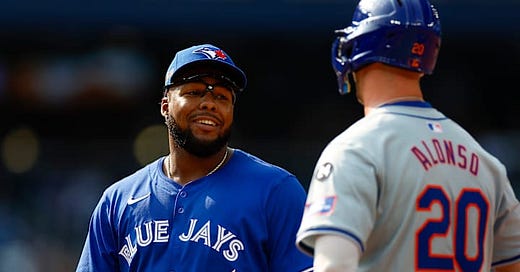



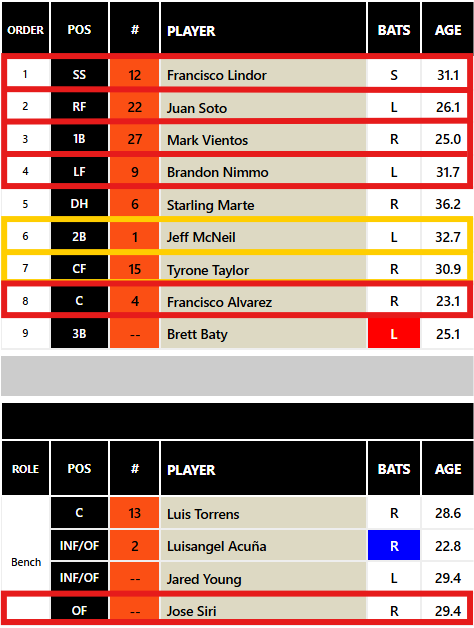
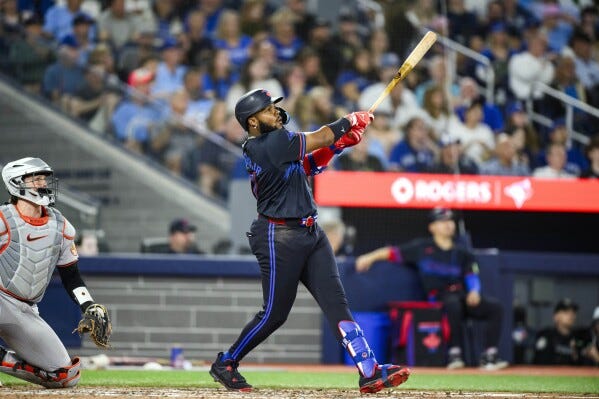
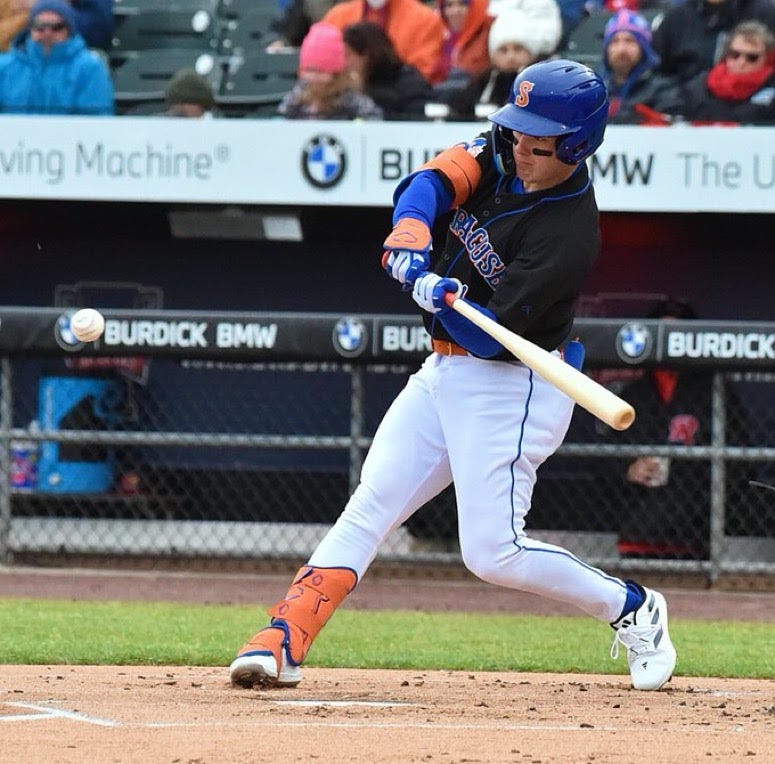
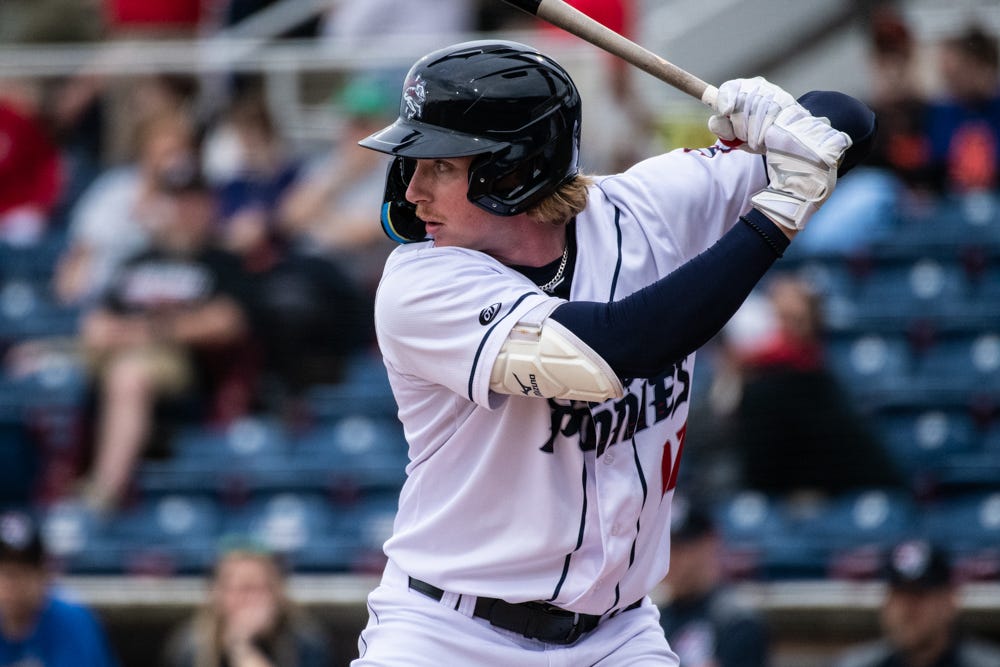
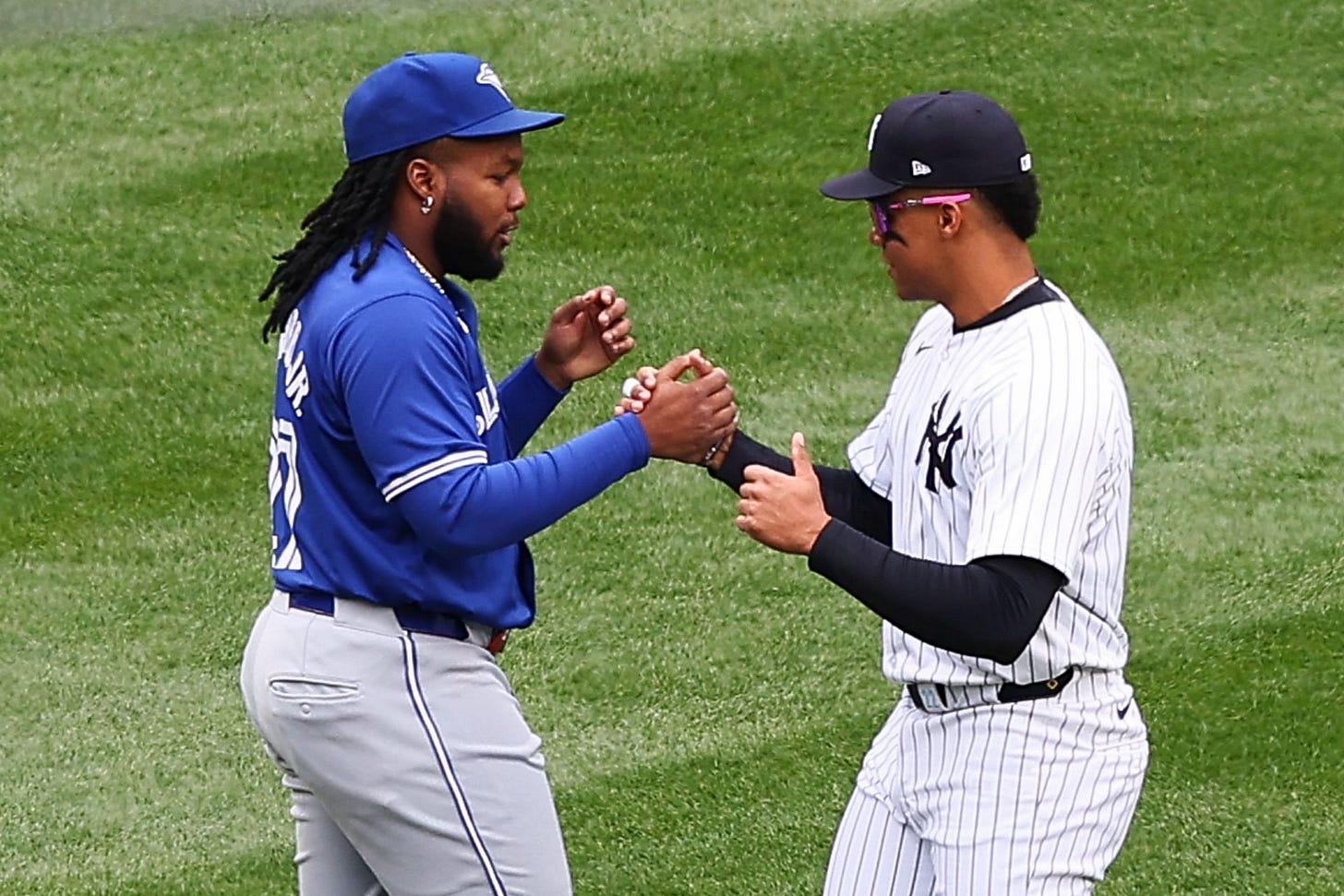


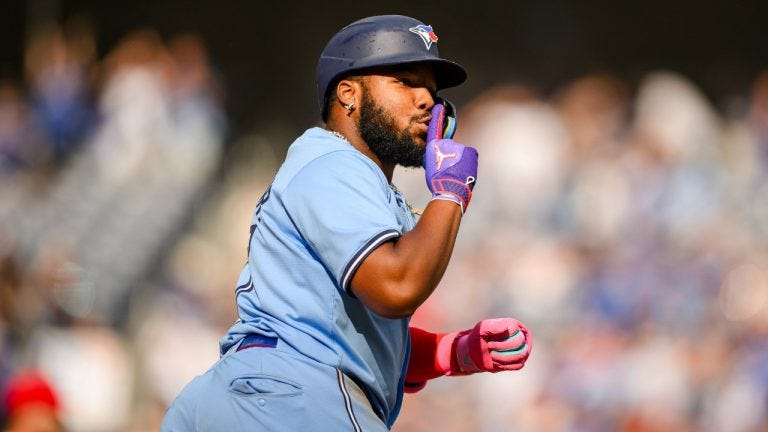
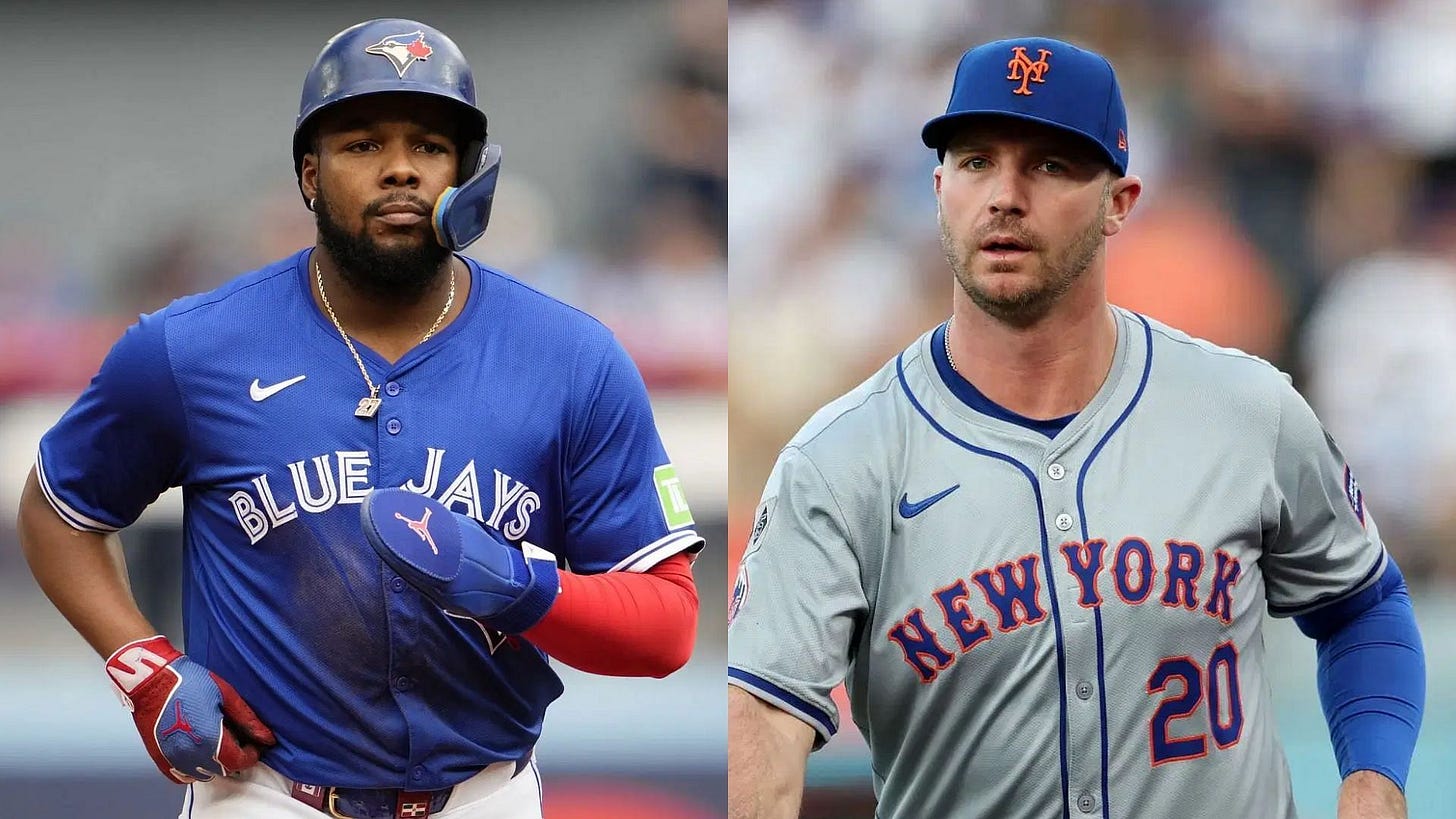
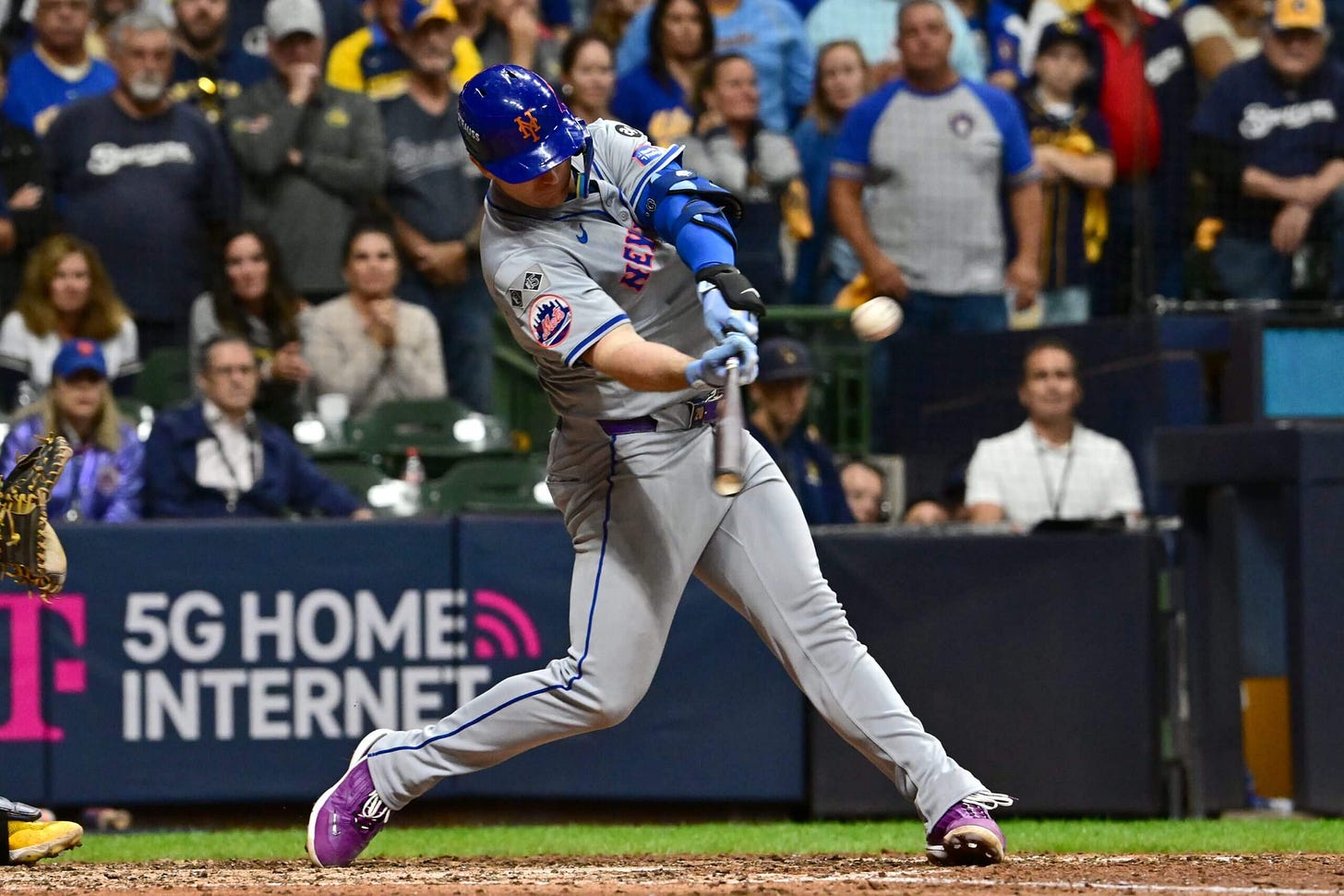

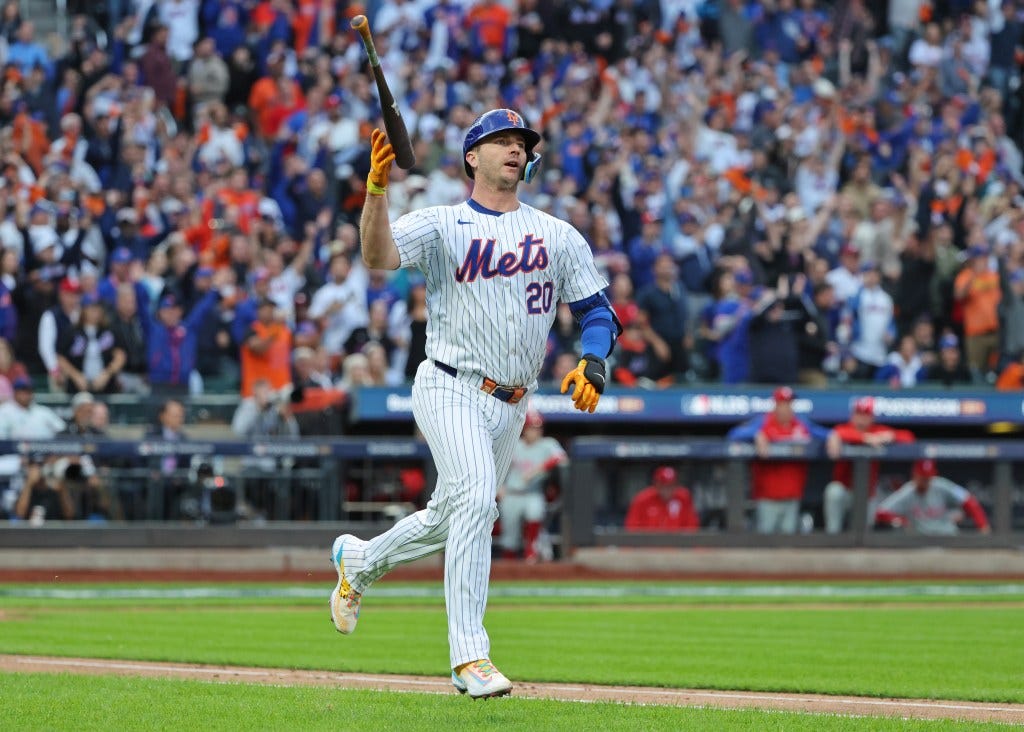
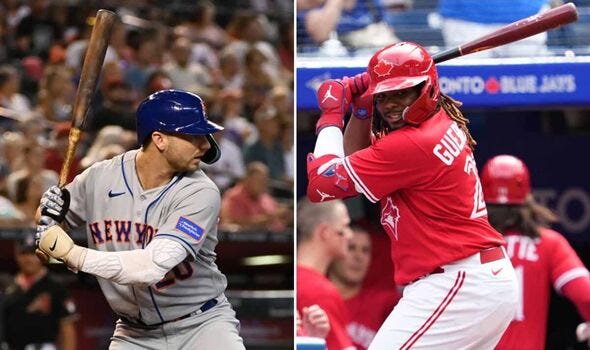
I've been thinking 5 years, $125 million for Pete, too. But something tells me we'll sweeten it a little with a hometown bonus and make it 5 years and $140 million, maybe with a tail-end mutual option to seal the deal.
That would be pretty generous, in my opinion. It would mean topping Freddie Freeman's AAV.
But if he's holding out for $200 million, Pete is going to be disappointed. He's not going to find that anywhere unless a GM has lost their mind.
As for Vladdy, he's a great fit for us. But I don't know if Stearns wants to give up the prospects, especially Tidwell and Gilbert, and Toronto might not be looking to move Guerrero anyway. More likely they'll bring in another bat to protect him (Santander, maybe?) and convince him to ink a long-term deal.